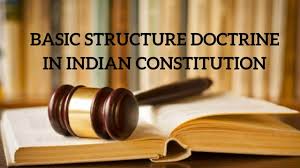Basic Structure doctrine – Polity Notes – For W.B.C.S. Examination.
The basic structure doctrine is an Indian judicial norm that the Constitution of India has certain basic features that cannot be changed or destroyed through amendments by the parliament.Continue Reading Basic Structure doctrine – Polity Notes – For W.B.C.S. Examination.
The “basic features” principle was first explained in 1964, by Justice J.R. Mudholkar in his disagreement, in the case of Sajjan Singh v. State of Rajasthan. He wrote, “It is also a matter for consideration whether making a change in a basic feature of the Constitution can be regarded merely as an amendment or would it be, in effect, rewriting a part of the Constitution; and if the latter, would it be within the purview of Article 368 ?”
The basic features of the Constitution have not been openly defined by the Judiciary. At least, 20 features have been described as “basic” or “essential” by the Courts in numerous cases, and have been incorporated in the basic structure. In Indira Nehru Gandhi v. Raj Naraian and also in the Minerva Mills case, it was witnessed that the claim of any particular feature of the Constitution to be a “basic” feature would be determined by the Court in each case that comes before it.
Several aspects of the Constitution termed as “basic” are mentioned below:
- Supremacy of the Constitution
- Rule of law
- The principle of Separation of Powers
- The objectives specified in the Preamble to the Constitution
- Judicial Review
- Articles 32 and 226
- Federalism (including financial liberty of states under Articles 282 and 293)
- Secularism
- The Sovereign, Democratic, Republican structure
- Freedom and dignity of the individual
- Unity and integrity of the Nation
- The principle of equality, not every feature of equality, but the quintessence of equal justice
- The “essence” of other Fundamental Rights in Part III
- The concept of social and economic justice – to build a Welfare State: Part IV in toto
- The balance between Fundamental Rights and Directive Principles
- The Parliamentary system of government
- The principle of free and fair elections
- Limitations upon the amending power conferred by Article 368
- Independence of the Judiciary
- Effective access to justice
- Powers of the Supreme Court under Articles 32, 136, 141, 142
- Legislation seeking to nullify the awards made in exercise of the judicial power of the State by Arbitration Tribunals constituted under an Act
Important elements among these “basic features”, are the fundamental rights granted to individuals by the constitution. The policy forms the basis of a limited power of the Supreme Court to review and strike down constitutional amendments passed by the Parliament which conflict with or seek to alter this “basic structure” of the Constitution. The basic structure doctrine applies only to constitutional amendments. The basic structure doctrine does not apply to ordinary Acts of Parliament, which must itself be in conformity with the Constitution.
Initial position of the Supreme Court on constitutional amendments was that no part of the Constitution was unamendable and that the Parliament might, by passing a Constitution Amendment Act in compliance with the requirements of article 368, amend any provision of the Constitution, including the Fundamental Rights and article 368.
In 1967, the Supreme Court reversed its earlier decisions in Golaknath v. State of Punjab. It held that Fundamental Rights included in Part III of the Constitution are given a “transcendental position” and are beyond the reach of Parliament. It also declared any amendment that “takes away or abridges” a Fundamental Right conferred by Part III as unconstitutional. By 1973, the basic structure doctrine succeeded in Justice Hans Raj Khanna’s judgment in the landmark decision of Kesavananda Bharati v. State of Kerala. Previously, the Supreme Court had held that the power of Parliament to amend the Constitution was unfettered. However, in this breakthrough ruling, the Court refereed that while Parliament has “wide” powers, it did not have the power to destroy or weaken the basic elements or fundamental features of the constitution.
Although Kesavananda was decided by a narrow margin of 7-6, the basic structure doctrine has since gained widespread approval and legality due to subsequent cases and judgments. Primary among these was the imposition of a state of emergency by Indira Gandhi in 1975, and her subsequent attempt to suppress her trial through the 39th Amendment. When the Kesavananda case was decided, the underlying apprehension of the majority bench that elected representatives could not be trusted to act responsibly and was perceived as unparalleled. However, the passage of the 39th Amendment by the Indian National Congress’ majority in central and state legislatures, proved that in fact such apprehension was well-founded. In Indira Nehru Gandhi v. Raj Narain and Minerva Mills v. Union of India, Constitutional Benches of the Supreme Court used the basic structure doctrine to knock down the 39th Amendment and parts of the 42nd Amendment respectively, and paved the way for restoration of Indian democracy. The Supreme Court’s position on constitutional amendments laid out in its judgements is that Parliament can amend the Constitution but cannot destroy its “basic structure”.
To summarize, all these features of the Indian Constitution is a constitution suitable to the Indian environment. The Constitution assist India to organise and operate government and administration in an effective way both in the times of peace and war. The basic structure of the Constitution and its most fundamental features are Preamble, Fundamental Rights, and Directive Principles.
Guided by WBCS Gr A Officers , Online and Classroom, Call 9674493673, or mail us at – mailus@wbcsmadeeasy.in
Visit our you tube channel WBCSMadeEasy™ You tube Channel
Please subscribe here to get all future updates on this post/page/category/website


 Toll Free 1800 572 9282
Toll Free 1800 572 9282  mailus@wbcsmadeeasy.in
mailus@wbcsmadeeasy.in



















































































































